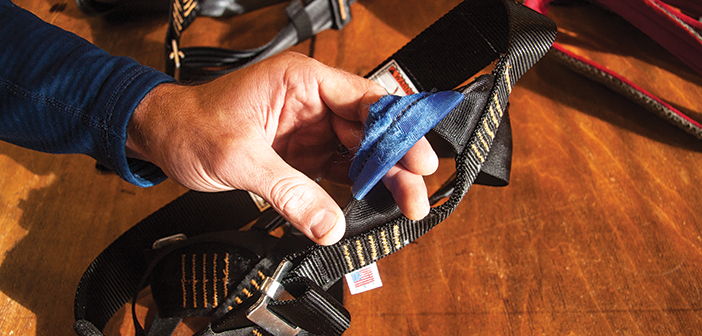CLEANING
Stevens’ advice for general cleaning of harnesses is to “use a large, 55-gallon drum or garbage can, fill it with water, use a mild soap, and agitate the harnesses by hand.” After harnesses are washed, he says, transfer them to another drum to be rinsed, and then hang them to dry—preferably in a cool, dry room, and not under the sun. Avoid the temptation to use hair dryers or heat guns to hasten the process. He says to expect around 24 hours for them to become fully dry.
After drying, if the web still feels stiff, this may indicate that too much soap was used, or the harness was not rinsed thoroughly enough. In either case, additional rinsing is the solution.
The cleaning agent itself is critical. It should be as mild as possible and still get the job done. “I try to get clients to use some kind of soap,” Stevens says, rather than detergents, which are a blend of chemicals that can damage synthetic fabrics. Woolite and bleach are also not recommended. Petzl’s guidelines also recommend soap only, as “solvents, stain removers, degreasers, etc., are too strong … [they]are incompatible with nylon and can damage the product.”
So how can an operator make sure the cleaning agent is mild enough? “Anything that you can use against your skin is a mild soap,” says Stevens.
In fact, since any number of chemicals can damage harnesses, it’s wise to exercise caution and prevent gear from being exposed to them in all instances, but especially during storage and cleaning. And damaging chemicals can be found in common household products. In 2013, an unusual (and non-injuring) failure of a Black Diamond harness led the company to run a series of tests, which revealed that products containing varying concentrations of muriatic, sulfuric and hydrochloric acids (such as plant fertilizers and car batteries) could contaminate nylon and cause it to fail.
STORAGE
Since UV light can be a source of damage, Hoffman believes it’s essential to store harnesses indoors in a cool, dry space with plenty of ventilation. “I have seen some operators store them outside during the day for the convenience factor while operations are open, but we don’t believe this is good policy,” Hoffman says.
Additionally, he recommends operators keep all equipment on site. When gear leaves the site, operators lose control of the storage conditions. For example, if harnesses are left in the trunk of a car, there may be abrasive chemicals, sharp objects or other hazards present. Establishing a proper storage place takes that variable out of the equation, Hoffman said.
And what about temperature? Robertson Harness advises that harnesses should be stored within a temperature range of 120º and -80º F—a large range, to be sure, but temperatures above and below those limits can cause significant damage.
To make sure storage conditions remain dry, Rivers makes sure he has fans and ample ventilation in his storage rooms. He also leaves extra time for harnesses to dry if he is storing them over the off-season. That reduces the chance of finding harnesses struck with mildew at the onset of the following season.
LONGEVITY
Most harnesses come with a recommended lifespan, but manufacturers are quick to point out that the many variables with harness use at adventure parks make individual usage the most important factor. The volume of clientele, environmental factors such as altitude, humidity, proximity to the coast, and more can all have a huge effect on the lifespan of the equipment.
“The life expectancy of a harness is a general guideline and not intended to be used as an absolute,” Robertson advises in its documentation. Stevens, who spent years working with an adventure park before joining Robertson, points out that his park handled an average of 1,800 clients a day, and had a zip line with speeds of up to 60 mph. That level of usage and wear and tear clearly shortened the equipment’s lifespan.
To help operators work through the variables, Robertson has graphed out information that provides different usage scenarios operators can use to gauge the usage of their gear. This information can help operators know how much wear and tear has been delivered to the harness as well as the cost effectiveness of each harness purchase.
Hoffman, with Misty Mountain, says most harnesses last two to three years with normal use, but again stresses that lifespan can vary widely. He points out that a summer camp will involve a fraction of the usage a year-round course will entail. That’s why he recommends every operator keep a detailed logbook of when the harness was purchased, how often it was used, if the harness was involved in a rescue, fall or other scenario, and other details.
Rivers believes in erring on the side of safety. “I follow the manufacturers guidelines, but there is no guarantee they will last that long. I try to retire harnesses when they reach the end of manufacturers’ stated lifespan, or when it fails visual inspection, whichever comes first.”
Overall, both manufacturers and course managers view the protocols and inspection practices as very successful. They all recognize that scrutiny is increasing as parks continue to see growth. And that scrutiny serves as a constant reminder to stay vigilant about maintaining one of the most important pieces of gear in the industry.
Attention to detail and new maintenance techniques seem to be constantly evolving and improving. “When I started working with one course, the training and safety logbook, which included harness care, was one page long. Ten years later, it was 34 pages. Most operators are very on point,” says Stevens. The growth of the industry will require that operators remain so.



